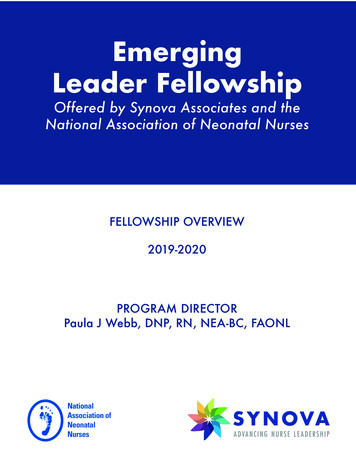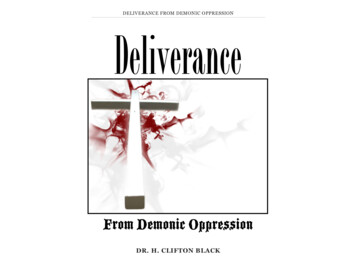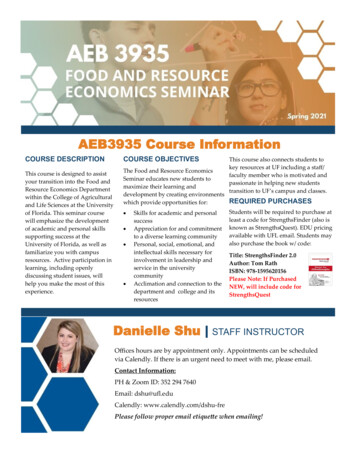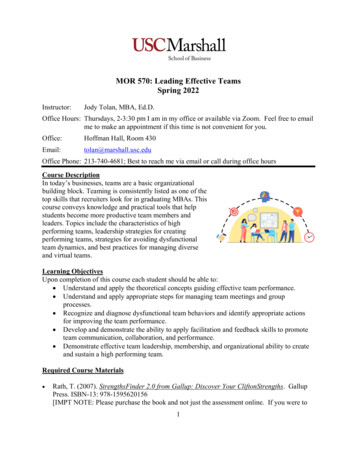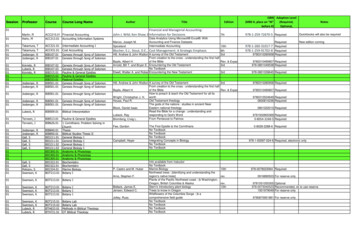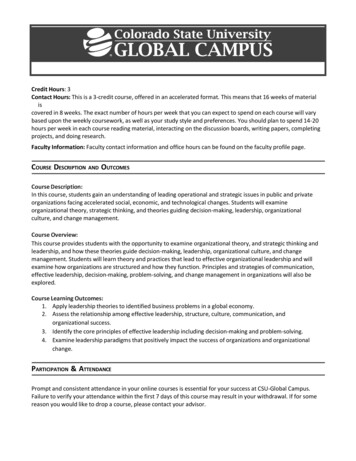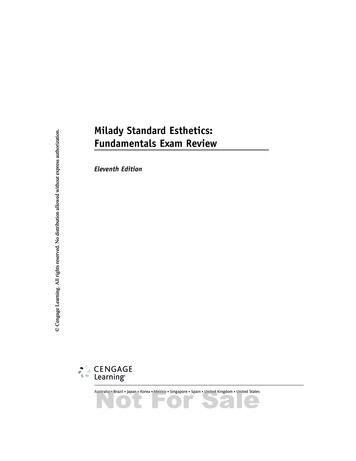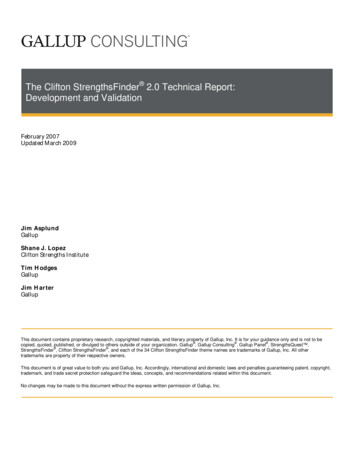
Transcription
The Clifton StrengthsFinder 2.0 Technical Report:Development and ValidationFebruary 2007Updated March 2009Jim AsplundGallupShane J. LopezClifton Strengths InstituteTim HodgesGallupJim HarterGallupThis document contains proprietary research, copyrighted materials, and literary property of Gallup, Inc. It is for your guidance only and is not to be copied, quoted, published, or divulged to others outside of your organization. Gallup , Gallup Consulting , Gallup Panel , StrengthsQuest , StrengthsFinder , Clifton StrengthsFinder , and each of the 34 Clifton StrengthsFinder theme names are trademarks of Gallup, Inc. All othertrademarks are property of their respective owners.This document is of great value to both you and Gallup, Inc. Accordingly, international and domestic laws and penalties guaranteeing patent, copyright,trademark, and trade secret protection safeguard the ideas, concepts, and recommendations related within this document.No changes may be made to this document without the express written permission of Gallup, Inc.
The Clifton StrengthsFinder 2.0 Technical ReportAbstractGallup’s Clifton StrengthsFinder is an online measure of personal talent that identifiesareas where an individual’s greatest potential for building strengths exists.The 177-item pairs were based on the theory and research foundation associated withsemi-structured personal interviews that had been used by Selection ResearchIncorporated and Gallup (Harter, Hayes, & Schmidt, 2004; Schmidt & Rader, 1999) forover 30 years. The measure, developed through rational and empirical processes, hasbeen repeatedly subjected to psychometric examination; a summary of reliability andvalidity evidence gathered to date is presented.The primary application of the Clifton StrengthsFinder, as the evaluation that initiates astrengths-based development process in work and academic settings, is discussed.The authors would like to thank Steve Sireci of the University of Massachusetts for hisinvaluable advice and comments about this research.For more information, please contact Jim Asplund at jim asplund@gallup.com or 952-806-0630.Copyright 2005, 2007, 2009 Gallup, Inc. All rights reserved.2
The Clifton StrengthsFinder 2.0 Technical ReportIntroductionThe Clifton StrengthsFinder (CSF) has been subjected to repeated psychometric scrutinyby its developers. The purpose of this manuscript is to describe the development andapplication of the CSF and to summarize its psychometric support to date, in accordancewith The Standards for Educational and Psychological Testing (American EducationalResearch Association, American Psychological Association, & National Council onMeasurement in Education, 1999).The Purpose of the Clifton StrengthsFinderThe validity of an assessment must be evaluated with respect to its intended purpose.The CSF is an online measure of personal talent that identifies areas where anindividual’s greatest potential for building strengths exists. By identifying one’s top themesof talent, the CSF provides a starting point in the identification of specific personal talents,and the related supporting materials help individuals discover how to build upon theirtalents to develop strengths within their roles. The primary application of the CSF is as anevaluation that initiates a strengths-based development process in work and academicsettings. As an omnibus assessment based on positive psychology, its main applicationhas been in the work domain, but it has been used for understanding individuals andgroups in a variety of settings — employee, executive team, student, family, and personaldevelopment.The CSF is not designed or validated for use in employee selection or mental healthscreening. Given that CSF feedback is provided to foster intrapersonal development,comparisons across profiles of individuals are discouraged.How the Clifton StrengthsFinder Is ScoredThe precise scoring of the CSF is proprietary to Gallup, Inc. What follows is a generaldescription of the scoring method so that readers can better understand the types ofvalidity analyses that can and cannot be done.The CSF is an online assessment in which each respondent is presented with 177 stimuliand makes 177 responses. Each item lists a pair of potential self-descriptors, such as “Ilike to help people.” The descriptors are placed as if anchoring opposite poles of acontinuum. From that pair, the respondent is asked to choose the statement that bestdescribes him or her, and also the extent to which that chosen option is descriptive of himor her. The participant is given 20 seconds to respond to a given item before the systemmoves on to the next item (developmental research showed that the 20-second limitresulted in a negligible item non-completion rate.)Copyright 2005, 2007, 2009 Gallup, Inc. All rights reserved.3
The Clifton StrengthsFinder 2.0 Technical ReportAn example of the item format is presented in Figure 1. This illustrates how each item ispresented on the screen:Figure 1Most of these descriptors are associated with a “theme.” A theme is a category of talents,which are defined as recurring and consistent patterns of thought, feeling, or behavior.The CSF measures the presence of talent in 34 distinct themes. (A complete set of themedescriptions is included in Appendix A). For example, one of these themes is “Positivity.”Several statements within the CSF measure “Positivity,” and there are 33 other themesconfigured in the same way; that is, multiple statements measuring each theme. Thenumber of statements varies by theme, as shown in Table 1.Copyright 2005, 2007, 2009 Gallup, Inc. All rights reserved.4
The Clifton StrengthsFinder 2.0 Technical ReportTable 1: Number of Statements Associated With Each ThemeCSF ThemeTotal Numberof eEmpathyFocus67811131199788481014612CSF icanceStrategicWooTotal Numberof Items8577651087128116131249Some statements are linked to more than one theme. Also, for some items, each of the twostatements within that item is linked to a separate theme. Thus, one response on an item cancontribute to two or more theme scores. A proprietary formula assigns a value to eachresponse category. Values for items in the theme are aggregated to derive a theme score.The calculation of scores is based on the mean of the intensity of self-description. Scores arerecorded in Gallup’s database as theme means, standard scores, and percentiles (derivedfrom Gallup’s database of more than 3.9 million respondents at the time of this writing).Results are presented to the respondent as a ranked ordering of Signature Themes, wherethe five highest scoring themes are provided to the respondent. Absolute scores are used torank the themes, with percentiles against the database norms and theme reliabilities used assubsidiary ranking factors. These theme-rank data are also recorded into the Gallup database.Given the intended use of the CSF for intrapersonal development, these theme-rank data arethe focus of feedback that is given to the respondent.Copyright 2005, 2007, 2009 Gallup, Inc. All rights reserved.5
The Clifton StrengthsFinder 2.0 Technical ReportStrengths TheoryWhen educational psychologist Donald O. Clifton first designed the interviews thatsubsequently became the basis for the CSF, he began by asking, “What would happen ifwe studied what is right with people?” Thus emerged a philosophy of using talents as thebasis for consistent achievement of excellence (strength). Specifically, the strengthsphilosophy is the assertion that individuals are able to gain far more when they expendeffort to build on their greatest talents than when they spend a comparable amount ofeffort to remediate their weaknesses (Clifton & Harter, 2003).Clifton hypothesized that these talents were “naturally recurring patterns of thought,feeling, or behavior that can be productively applied” (Hodges & Clifton, 2004, p. 257).“Strengths” are viewed as the result of maximized talents. Specifically, a strength ismastery created when one’s most powerful talents are refined with practice andcombined with acquired relevant skills and knowledge. The CSF is designed to measurethe raw talents that can serve as the foundation of strengths. Thus the purpose of theinstrument is to identify Signature Themes of talent that serve as a starting point in thediscovery of talents that can be productively applied to achieve success.Development of the Clifton StrengthsFinderGallup, widely known for its polls (Gallup, 2004; Newport, 2004) and employee selectionresearch (Harter, Hayes, & Schmidt, 2004; Schmidt & Rader, 1999) developed numeroussemi-structured interviews to identify talent that could be enhanced and used to pursuepositive outcomes in work and school. In the 1990s, under the leadership of Donald O.Clifton, Gallup developed the CSF as an objective measure of personal talent that couldbe administered online in less than one hour.Clifton, over his 50-year career at the University of Nebraska, Selection ResearchIncorporated, and Gallup, studied “frames of reference” (Clifton, Hollingsworth, & Hall,1952), teacher-student rapport (Dodge & Clifton, 1956), management (Clifton, 1970;1975; 1980), and success across a wide variety of domains in business and education(Buckingham & Clifton, 2000; Clifton & Anderson, 2002; Clifton & Nelson, 1992). Hebased his research and practice on straightforward notions that stood the test of time andempirical scrutiny.First, he believed that talents could be operationalized, studied, and capitalized upon inwork and academic settings. Talents are manifested in life experiences characterized byyearnings, rapid learning, satisfactions, and timelessness. These trait-like “raw materials”are believed to be the products of normal healthy development and successfulexperiences over childhood and adolescence. “Strengths” are viewed as extensions oftalent. More precisely, the strength construct combines talents with associated knowledgeand skills and is defined as the ability to consistently provide near-perfect performance ina specific task. (Though labeled the Clifton StrengthsFinder, the instrument actuallymeasures the talents that serve as the foundations for strengths development.)Second, Clifton considered success to be closely associated with personal talents andstrengths in addition to the traditional constructs linked with analytical intelligence. Inaccordance with those beliefs, he worked to identify hundreds of “themes” (categories) ofpersonal talents that predicted work and academic success, and he constructedempirically-based, semi-structured interviews for identifying these themes. Whendeveloping the interviews, Clifton and analysts examined the prescribed roles of a personCopyright 2005, 2007, 2009 Gallup, Inc. All rights reserved.6
The Clifton StrengthsFinder 2.0 Technical Report(e.g., student, salesperson, administrator), visited the job site or academic setting,identified outstanding performers in these roles and settings, and determined the longstanding thoughts, feelings, and behaviors associated with situational success. Many ofthe interviews developed provided useful predictions of positive outcomes (Schmidt &Rader, 1999). These interviews subsequently were administered by Gallup analysts tomore than two million individuals for the purposes of personal development andemployee selection. In the mid-1990s, when considering the creation of an objectivemeasure of talent, Clifton and colleagues systematically reviewed these interviews andthe data they generated to capitalize on the accumulated knowledge and experience ofGallup’s strengths-based practice.The prominence of dimensions and items relating to motivation and to values in much ofthe interview research informed the design of an instrument that can identify thoseenduring human qualities. An initial pool of more than 5,000 items was constructed on thebasis of traditional validity evidence. Given the breadth of talent assessed, the pool ofitems was considered large and diverse. A smaller pool was derived subsequent toquantitative review of item functioning and a content review of the representativeness ofthemes and items within themes (with an eye toward the construct validity of the entireassessment). Specifically, evidence used to evaluate the item pairs was taken from adatabase of criterion-related validity studies, including over 100 predictive validity studies(Schmidt & Rader, 1999). Factor and reliability analyses were conducted in multiplesamples to assess the contribution of items to measurement of themes and theconsistency and stability of theme scores — thereby achieving the goal of a balancebetween maximized theme information and efficiency in instrument length. Duringdevelopment phases, a number of sets of items were pilot tested. The items with thestrongest psychometric properties (including item correlation to theme) were retained.In 1999, a 35-theme version of the CSF was launched. After several months of data werecollected, researchers revisited the instrument and, based on analyses of themeuniqueness and redundancy, decided on 180 items and 34 themes. Since 1999, sometheme names have changed, but the theme descriptions have not changed substantially.(See Appendix A for a listing and descriptions of the 34 themes.)Today, the CSF is available in more than 20 languages and is modifiable for individualswith disabilities. It has been taken by more than 3.9 million individuals all over the world.It is appropriate for administration to adolescents and adults with a reading level of grade10 or higher. In 2006, Gallup researchers undertook a comprehensive review of CSFpsychometrics, which led to some revisions in the instrument. Confirmatory studies(presented in a subsequent section) validated the 34-theme structure in both adult andstudent populations. In the course of reviewing more than one million cases in multiplestudies, some possible improvements in theme validities and reliabilities were identified.Some of these improvements involved rescoring of existing items, whereas othersrequired the addition of new items. These new items were drawn from Gallup’s library oftalent-related items, and from researchers’ experience in building structured interviewsand providing talent feedback. Finally, there were items that had been included in the180-item version of the CSF, but never used in theme scores. A thorough review of eachof these items showed many to be unnecessary as either distracters or scored items.They were consequently removed. The result of all of these item changes was a slightreduction in the length of the instrument, from 180 items to 177.Copyright 2005, 2007, 2009 Gallup, Inc. All rights reserved.7
The Clifton StrengthsFinder 2.0 Technical ReportResearchers both inside and outside Gallup contributed a number of the investigationsinto the CSF’s continuing reliability, validity, and applicability to both the generalpopulation and college students in particular. Those most recent studies have included: Confirmatory studies:––––– Reliability studies:––––––– Schreiner (Azusa Pacific): n 438Lopez, Harter, Hodges: n 706Asplund: n 110,438Asplund: n 250,000Asplund: n 472,850Asplund: n 2,219Asplund: n 46,905Other validity studies:––– Sireci (University of Massachusetts): n 10,000Lopez (University of Kansas), Hodges (Gallup), Harter (Gallup): n 601,049Asplund (Gallup): n 110,438Asplund: n 250,000Asplund: n 472,850Lopez, Hodges, Harter: n 297Schreiner: n 438Stone (Harvard): n 278Utility studies:––Asplund: n 90,000 employees in over 900 business unitsVarious additional case studiesSeparately, each of these studies affirms the ongoing viability of the CSF. Moreimportantly, the collective evidence of all this work is convergent regarding thepsychometric properties of the CSF, as well as regarding the details of its validity.Notwithstanding the confirmatory evidence provided by this body of research, Gallupresearchers identified some areas in which the CSF could be improved psychometrically.In particular, it was observed that some of the items could be improved, removed, orreplaced. As a logical first step to improving the psychometrics, Gallup researchersthoroughly examined each unscored statement to see whether it could be used toimprove the performance of the assessment. Unscored statements that showed no utilitywere removed, if possible. (Several of the unscored statements are paired with a scoredstatement, and therefore are not subject for removal at this time.)Copyright 2005, 2007, 2009 Gallup, Inc. All rights reserved.8
The Clifton StrengthsFinder 2.0 Technical ReportAdministration and FeedbackFeedback varies in accordance with the reason the person completes the CSF. Summaryscores are not provided to respondents. In most cases the respondent receives a reportlisting his or her top five talent themes — those in which the person received his or herhighest scores, in order of intensity — the aforementioned Signature Themes. In othersituations the respondent may review his or her sequence of all 34 themes, along with“action items” for each theme, in a personal feedback session with a Gallup consultant orin a supervised team-building session with colleagues. In programs designed to promotestrengths-based development, feedback is often accompanied by instruction, experientiallearning, and mentoring activities designed to help people make the most of their talents(i.e., develop strengths associated with occupational or educational roles).As part of this update to the CSF, a new, more detailed type of feedback is provided:talent descriptions that go beyond the Signature Themes by looking at item-levelresponses. These “strengths insights” provide a more customized version of therespondent’s Signature Themes report featuring a more in-depth dive into the nuances ofwhat makes him or her unique, using more than 5,000 new personalized strengthsinsights that Gallup researchers have discovered in recent years. This feedback based onboth theme and item-level data provides a more rich description of the particularcombination of responses provided by the participant.Application: Strengths-Based DevelopmentThe CSF is often used as a starting point for self-discovery in Gallup strengths-baseddevelopment programs. After a respondent has completed the assessment and talentfeedback is provided, a set of developmental suggestions is customized to the individual’sSignature Themes and to his or her role to help integrate his or her talents into a moreinformed view of self. As the identification and integration stages of strengths developmentunfold, behavioral change is encouraged. Specifically, the strengths-based developmentprocess encourages individuals to build strengths by acquiring skills (i.e., basic abilities)and knowledge (i.e., what you know, including facts and meaning-making fromexperiences) that can complement their greatest talents in application to specific tasks.The CSF’s intended purpose is to facilitate personal development and growth. It isintended and used as a springboard for discussion with managers, friends, colleaguesand advisers, and as a tool for self-awareness. CSF results are viewed as a preliminaryhypothesis to be verified with the respondent. Accordingly, feedback about talents andstrengths development often forms the basis of further interventions that help individualscapitalize on their greatest talents and apply them to new challenges. For this application,the psychometric properties of the instrument are more than adequate.Copyright 2005, 2007, 2009 Gallup, Inc. All rights reserved.9
The Clifton StrengthsFinder 2.0 Technical ReportReliabilityThe reliability of a score is an estimate of its stability, or the portion of the score not dueto random variation. For instruments like the CSF, two types of reliability estimates aregenerally used: Internal Consistency. In general, this involves looking at how well the items designedto measure the same thing produce the same results. Cronbach’s alpha is a commonlyused measure of this type of reliability.Test-Retest Reliability. This is employed by administering the instrument to the samesample at two different time periods. It is generally more difficult to acquire these data,as one has to get the respondent to complete the instrument twice.Practical concerns will limit the number of items that can be used, but mathematicallyspeaking, the more items the better (within reason). The same is true for validity; havingmore items should usually imply more coverage of the construct domain. There will be acumulative effect on validity because each item taps into a slightly different aspect of theconstruct in question, or the criterion being predicted.Estimates of internal consistency reliabilities for the CSF are included in Table 2.Estimates are provided from two independent samples — a random sample of 46,902respondents from 2008, and the 2,219 respondents from the test-retest study describedin the following section. (Alphas shown are from the initial test.) Readers will note thestrong similarity of the two sets of results.Copyright 2005, 2007, 2009 Gallup, Inc. All rights reserved.10
The Clifton StrengthsFinder 2.0 Technical ReportTable 2: Estimates of Internal Consistency ReliabilitiesThemeAlpha:(n 46,902)Alpha:Retest Sample(n opyright 2005, 2007, 2009 Gallup, Inc. All rights reserved.11
The Clifton StrengthsFinder 2.0 Technical ReportCronbach's alpha is heavily biased by the number of items in a theme. In fact, it is verydifficult to obtain extremely high alphas for an instrument that measures 34 dimensions,such as the CSF. Because the goal of the CSF was to create an efficient assessment thatoptimized validity, efforts to increase the alphas could potentially be detrimental to thepurpose of the CSF. That is, alphas could be optimized by making the instrumentconsiderably longer. For example, items could be added to “Context” to give it higheralphas, but when you add items you are removing degrees of freedom in the scale andessentially building a theme that measures just one aspect of Context. The high alphacould therefore cost content validity and, in all likelihood, criterion validity. Criteria such asalpha are meaningful only to the extent to which they reflect improved validity. In caseslike that of the CSF (measuring broad domains), they often do not.Gallup recently conducted a test-retest study consisting of 2,219 members of the Gallup Panel,a nationally representative, probability-based panel of U.S. households that have agreed toparticipate in Gallup Panel surveys by phone, Web, or mail on any topic at any time.Respondents were recruited to complete the CSF assessment in February of 2008.Those who completed the assessment received no feedback or output of any kindregarding their Signature Themes; nor were they informed that they were participating ina study of the CSF. This was done to enable as pure an evaluation of the CSF’s testretest reliabilities as possible. After completing the assessment, respondents wererandomly assigned to one of three retest periods: (1) one month (n 538), (2) threemonths (n 390), and (3) six months after their first assessment (n 376). The results ofthis study are shown in Table 3.Copyright 2005, 2007, 2009 Gallup, Inc. All rights reserved.12
The Clifton StrengthsFinder 2.0 Technical ReportTable 3: Test-Retest Reliability 720.650.710.76Copyright 2005, 2007, 2009 Gallup, Inc. All rights reserved.13
The Clifton StrengthsFinder 2.0 Technical ReportAs indicated in Table 3, test-retest correlations were generally consistent over thevarying time intervals. Only a handful of themes showed notable changes over thelongest retest period.Recruiting from the Gallup Panel provided the opportunity to test the effects of a greatnumber of covariates on CSF responses. Very few of these covariates were found tohave any differential impact on the test-retest reliabilities: Significance means dropped slightly more among women in the 3-month and 6-monthretests.Analytical means dropped slightly more among women in the 3-month retest, whereasmen’s scores increased slightly more in the 6-month retest.Individualization mean changes varied by education level in both the 3-month and 6month retests, but because these changes were not directionally consistent, the effectsof education on reliabilities appear artifactual.Given that the “scores” presented to respondents are rank-ordered themes, the reliabilityof the score profile is also a critical issue. A Chi-Square test of independence wasconducted on each theme, with the dichotomous variables labeled as “theme in top fiveduring pretest” and “theme in top five during posttest.” Of the 34 themes, 33 hadsignificant Chi-Square results, indicating that their presence in the top five on the pretestwas significantly related to their presence in the top five in the posttest. This findingprovides evidence for the stability of the vast majority of the themes from the pretest tothe posttest. However, one theme’s posttest was independent of its pretest, meaning itwas less stable over time in this sample. That theme was Self-Assurance, the raresttheme in the sample. It must be noted that, for most respondents, any new SignatureThemes in the posttest had been in the respondent’s top ten themes on the pretest,indicating that some of the apparent lack of temporal consistency is an artifact of how theresults are reported.ValidityFrom a validity standpoint, the CSF looks very strong. That is, it seems to measure what itis supposed to measure. Studies have produced evidence of congruence with the Big Five(Harter & Hodges, 2003), 16PF (Schreiner, 2006), and CPITM (Schreiner, 2006). Gallupresearchers have also produced strong recent evidence of construct validity from largeconfirmatory studies looking at how the items “cluster.” These will be examined in turn.Copyright 2005, 2007, 2009 Gallup, Inc. All rights reserved.14
The Clifton StrengthsFinder 2.0 Technical ReportContent ValidityAn assessment should be inclusive of all aspects of the domain it is measuring. It isdifficult to provide content validity evidence for personality-type assessments. Don Cliftonand other Gallup researchers spent more than 30 years studying the traits that led tooptimal functioning in a broad array of areas — including schools, and numerous andvaried work environments — and across a wide expanse of time. The assessments thatwere developed as part of this research have been used to select or develop well over 2million individuals, giving Gallup researchers confidence in the content coverage of theCSF items and themes. Gallup continues to investigate this issue and welcomes anydiscussions about how to improve the content validity of any of the CSF themes, or theoverall instrument.Construct ValidityThe paired-statement design of the CSF limits the methods that can be used to showconstruct validity. Some statements are linked to multiple themes, and when thesestatements are chosen, the respondent’s score is counted multiple times, once foreach theme. When statements within an item are treated as two different items, thisbuilds a direct correlation between these “different” items that systematically biasesinter-theme correlations.Also, for those item pairs for which both statements are attached to themes, the selectionof one statement assigns points to the themes aligned with both statements. This lasttype of statement pair, where endorsing one statement also means a negative score forthe other statement, produces some of the properties of ipsativity in the data set.What is “ipsativity,” and what are its analytical ramifications? Kaplan and Saccuzzo(1982) provide a simple definition: Ipsative scores compare the individual against himselfor herself and produce data that reflect the relative strength of each need for that person;each person thus provides his or her own frame of reference. One of the classical signsof ipsativity would be equal means and standard deviations in the themes. Because fewerthan 30% of the items are ipsatively scored, we know that the instrument has limitedipsativity. Nevertheless, an examination of theme means and standard deviations wasmade to judge the amount of ipsativity present. This showed ipsativ
The validity of an assessment must be evaluated with respect to its intended purpose. . based his research and practice on straightforward notions that stood the test of time and empirical scrutiny. First, he believed that talents could be operationalized, studied, and capitalized upon in . The Clifton
